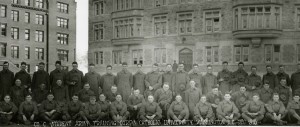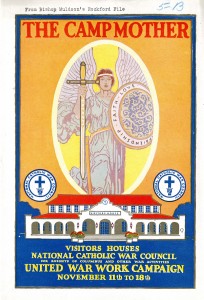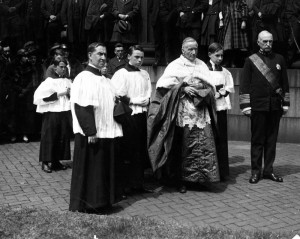
Each year November 11 is a special day in which we honor the nation’s military veterans. A previous blog post examined the American Civil War (1861-1865) relative to the grounds of what would become The Catholic University of America (CUA) in Washington, D.C. This post looks at the role of American Catholics in The World War, subsequently known as World War I that raged exactly one hundred years ago. Not coincidentally, the records and papers of many of the Catholic organizations and individuals mentioned hereafter are deposited in the Archives of CUA.

CUA was one of the first Catholic institutions to declare its war stance when university rector, Bishop Thomas J. Shahan, wrote on March 28, 1917 to U.S. President Woodrow Wilson, who replied two days later thanking him “for your pledge of cooperation and support.” Lay students recruited for a military drill on campus, forming three companies under the leadership of University instructors who had prior military experience. Many students also joined reserve or active duty units. In the spring of 1918, the War Department established the Students’ Army Training Corps (SATC), a precursor to the modern Reserve Officer’s Training Corps (ROTC), to prepare individuals for military service. The SATC was enthusiastically received and nearly 400 students were inducted, while Rev. Dr. Peter Guilday was appointed one of the SAC Regional Vice-Directors as a part of its academic component. Additionally, the War Department’s Chemical Service Section used Maloney Hall for chemical warfare experiments.
The American bishops, also hoping to demonstrate Catholic loyalty, created the National Catholic War Council (NCWC) after meeting at CUA, with the motto ‘For God and Country,’ to represent Catholic interests in Congress, address needs of soldiers and war workers at home and overseas, and promote the Americanization of recent immigrants. Paulist priest John J. Burke was put in charge with an executive council of delegates from the archdioceses, the Knights of Columbus, and the American Federation of Catholic Societies. Burke organized an ecumenical committee to advise the U.S. War Department, which in return recognized the NCWC as an official government agent in war welfare work, enabling it to participate in the United War Work Campaign of 1918 where it received thirty-six million dollars as its share of the fund drive. Following the Armistice, the National Catholic War Council was succeeded by the National Catholic Welfare Council, which has survived under several name changes into the twenty-first century, currently known as the United States Conference of Catholic Bishops (USCCB).

As part of or separate from the efforts of various American Catholic organizations, individual Catholics contributed to the war effort on many levels. Mrs. Stocks Millar was part of the NCWC’s overseas support operations providing aid and comfort to both soldiers and civilians. Admiral William Shepherd Benson (no relation), the first Chief of Naval Operations (1915-1919), who directed the war at sea, was the highest ranking Catholic in the U.S. military, and after the war was the first President of the National Council of Catholic Men (1921-1925). Bruce M. Mohler, subject of an earlier post and later director of the NCWC Immigration bureau/department, served as an officer of engineers (sanitation) in France and Poland while Robert L. O’Connell was an enlisted man who served as a combat engineer in France and Germany. Other Catholic soldiers, many of whom bravely paid the ultimate price, such as Matej Kocak, Aniello Spampanato, and Marcus B. Armijo, were later immortalized in D.J. Ryan’s newspaper column ‘Catholic Heroes of the World War.’ More recently, in August 2014, the Catholic News Service (CNS) remembered the American Catholic War effort in print and with two YouTube videos: WWI Impact on U.S. Catholics Part I and Catholic, WW I Archival Images, Part II.
